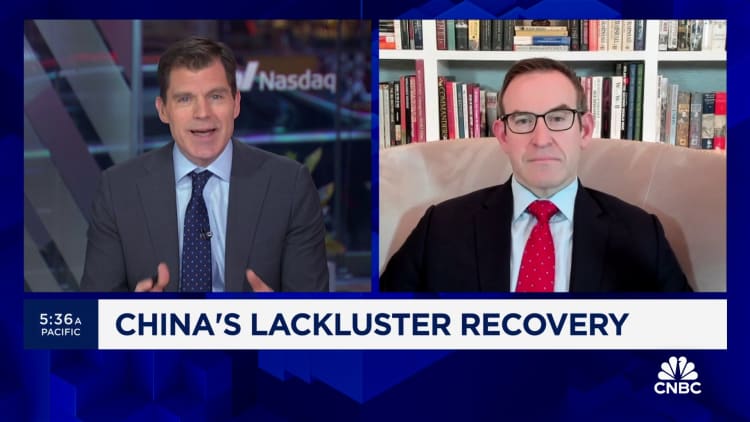Banknotes
of
Renminbi
arranged
for
photography
on
July
03
2018
in
Hong
Kong,
Hong
Kong.
S3studio
|
Getty
Images
News
|
Getty
Images
China’s
factory
activity
contracted
for
a
fourth
consecutive
month
in
January,
underscoring
the
much-needed
litany
of
policy
support
for
the
world’s
second-largest
economy
which
Beijing
announced
last
week.
The
official
manufacturing
purchasing
managers’
index
rose
slightly
to
49.2
in
January
from
49
in
December,
according
to data from
the
National
Bureau
of
Statistics released
Wednesday.
It
was
in
line
with
the
median
forecast
in
a
Reuters
poll.
The
official
non-manufacturing
managers’
index
rose
to
50.7
in
January
from
50.4
in
December,
according
to
NBS.
Strength
in
the
country’s
services
industry
helped
offset
weakness
in
the
construction
sector
amid
a
slump
in
the
real
estate
sector.
A
PMI
reading
above
50
indicates
expansion
in
activity,
while
a
reading
below
that
level
points
to
a
contraction.

watch
now
Of
the
five
sub-indexes
for
the
manufacturing
PMI,
new
orders
marginally
increased,
though
production
jumped
1.1
percentage
points.
Employment
for
both
non-manufacturing
and
manufacturing
sectors
edged
lower
in
December.
The
business
activity
index
for
the
construction
industry,
included
as
part
of
the
non-manufacturing
PMI,
stood
at
53.9
a
decrease
of 3.0 percentage
points.
Spring
Festival
effect
Zhao
Qinghe,
a
senior
statistician
at
China’s
NBS,
attributed
the
weakness
in
construction
to
factors
such
as
low
temperature
in
winter
and
the
approaching
Spring
Festival
holiday,
which
marks
the
start
of
industry’s
off-peak
season.
The
annual
Spring
Festival,
also
known
as
the
Lunar
New
Year,
starts
Feb.
10
this
year.
China
is
typically
shut
down
for
the
annual
week-long
holiday.
The
country’s
migrant
workers
typically
take
off
earlier
to
spend
more
time
with
their
families
in
their
hometowns,
given
that
Spring
Festival
may
be
the
only
time
in
the
year
that
some
see
their
families.
This
is
reflected
in
the
increased
propensity
for
travel
and
broader
consumption
demonstrated
in
January’s
non-manufacturing
PMI.
The
business
activity
index
for
the
retail,
road
and
air
transportation,
catering
and
other
related
industries
have
climbed
into
the
expansion
range,
while
those
for
railway
transportation
among
others
have
jumped
to
60
and
more,
Zhao
said
in
a
separate
release.
Policy
stimulus
Still,
the
broader
economic
outlook
is
a
patchy
one.
Pan
Gongsheng,
the People’s
Bank
of
China governor,
unexpectedly
announced
last
week
a
cut
in
the
amount
of
liquidity
that
banks
are
required
to
hold
as
reserves.
Later
that
day,
Beijing
released a
fresh
policy
mandate aimed
at
easing
the
cash
crunch
for
Chinese
developers,
which
have
struggled
under
the
crackdown
on
the
sector’s
bloated
debt.
The
property
market
slumped
after
Beijing
clamped
down
on
developers’
high
reliance
on
debt
for
growth
in
2020,
weighing
on
consumer
growth
and
the
broader
growth
in
the
Chinese
economy.
The
PBOC
has
said
there’s
room
for
further
monetary
policy
easing.
Reducing
the
reserve
requirements
that
banks
must
maintain
will
increase
the
capacity
for
lenders
to
extend
loans
and
spur
spending
in
the
broader
economy.
